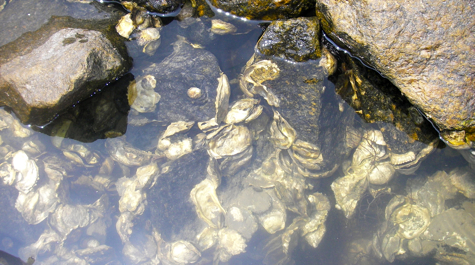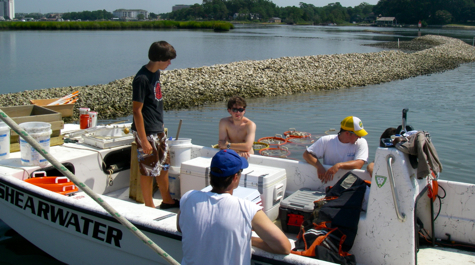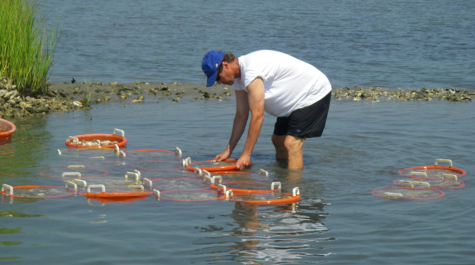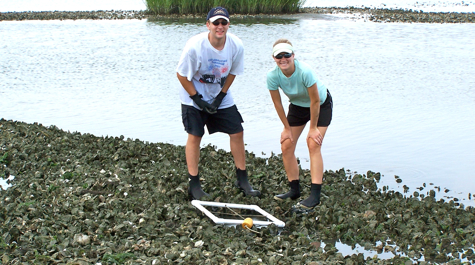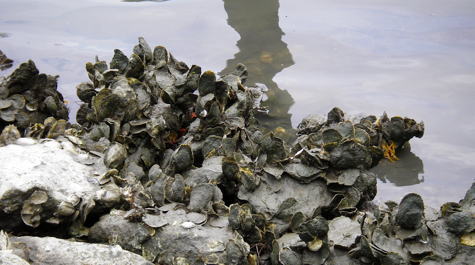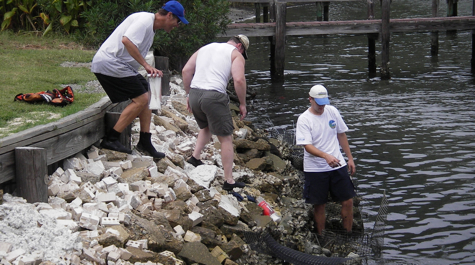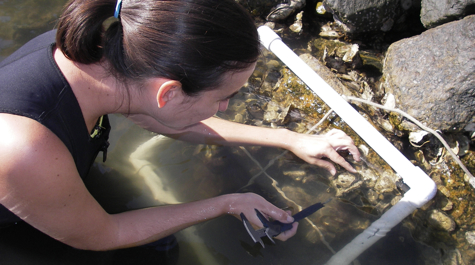VIMS a partner in Coastal America Award
The Lynnhaven River Oyster Restoration Team—a partnership between the Virginia Institute of Marine Science, Army Corps of Engineers, City of Virginia Beach, Virginia Marine Resources Commission, and Lynnhaven River NOW—has been selected to receive a 2009 Coastal America Partnership Award for innovative efforts to restore the river's native oyster population.
Coastal America is a group of federal agencies, state and local governments, and private organizations established in 1992 to protect, preserve, and restore the nation's coastal resources. Its annual awards recognize efforts to meet these goals through collaborative action and partnership.
The Lynnhaven River, whose watershed covers one-fourth the area of Virginia Beach, has become increasingly stressed as its watershed has urbanized. The river was a well-known oyster ground until disease, declines in water quality, and frequent shellfish closures shut down its fishery in the early 1970s. Once world-famous, "Lynnhaven Fancies" have become a rarity.
The Coastal America Partnership Award recognizes the restoration team for its coordinated effort to reverse this decline. During the last decade, the team has worked to identify and implement the most effective strategies for restoring oysters and bay grasses, improving water quality, and managing siltation.
The VIMS contingent of the restoration team, led by Professor Rom Lipcius, has used the latest science to improve the effectiveness of the oyster-restocking effort. Lipcius says "The oyster restoration effort in the Lynnhaven differs significantly from earlier efforts in the Bay in that it focused on ecological restoration, involved active collaboration among parties, and based its decisions on novel, state-of-the-art scientific methods."
Lipcius, Stan Allen, Ryan Carnegie, Mark Luckenbach, Danielle McCulloch, and Rochelle Seitz used innovative methods such as building higher reefs to escape siltation, positioning reefs to maximize retention of larvae, and planting of disease-resistant native oysters developed at VIMS.
Their studies suggest that the Lynnhaven held 10-20 million oysters before restoration. The oyster restoration team now estimates that between 60-90 million oysters inhabit the restored reefs. Many of these have grown to up to 6" long, evidence that they are healthy and may be developing resistance to the diseases that kill most Chesapeake Bay oysters while still young.
A key early component of the project was work by VIMS researchers Harry Wang, Jian Shen, and Mac Sisson, who refined the Institute's existing state-of-the-art computer model to accurately simulate water flow and quality within the Lynnhaven. Lipcius and Sebastian Schreiber, a mathematical modeler at W&M, used the model to identify areas of the river where restoration efforts were most likely to succeed. The Corps then built almost 60 acres of oyster reef in these areas. Free from oyster fishing, these reefs now provide one of the largest sanctuaries for native oysters worldwide.
Collection of information on the river's existing oyster population, data needed to gauge the success of subsequent efforts, required a variety of techniques. Luckenbach and colleague P.G. Ross used video and GPS to prepare high-definition maps of shoreline types, while Lipcius, Seitz, and graduate students Russ Burke and Amanda Lawless sampled rip-rap and other shorefront structures to quantify oyster numbers.
VIMS students and alumni have also played a role in the restoration project. David Schulte, the Corps' project leader, is a graduate student in the School of Marine Science at VIMS. VIMS alumna Laurie Sorabella (MSc 2002) is Assistant Director of Lynnhaven River NOW, a citizen's group that has been instrumental to the project's success.
In the coming years, the team plans to continue planting more spat-on-shell to increase oyster recruitment throughout the river. They also plan to construct about 40 more acres of reefs, with an ultimate goal of reaching a riverwide population of 200 million oysters.
Team members will receive the award during a ceremony in Virginia Beach on Thursday, January 14.

